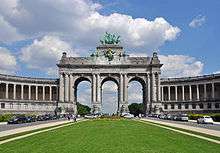Cinquantenaire
| Parc du Cinquantenaire (French) Jubelpark (Dutch) | |
|---|---|
|
The centrepiece Arc du Cinquantenaire and U-shaped arcade | |
| Type | Public leisure park, pedestrian square |
| Location | City of Brussels, Brussels-Capital Region, Belgium |
| Coordinates | 50°50′26″N 4°23′34″E / 50.84056°N 4.39278°ECoordinates: 50°50′26″N 4°23′34″E / 50.84056°N 4.39278°E |
| Area | 30 hectares (74 acres)[1] |
| Created | 1880 |
| Public transit access | Schuman and Mérode metro stations |
Parc du Cinquantenaire (French for "Park of the Fiftieth Anniversary", pronounced [paʁk dy sɛ̃kɑ̃tnɛʁ]) or Jubelpark (Dutch for "Jubilee Park", pronounced [ˈjybəlpɑrk]) is a large public, urban park (30 hectares) in the easternmost part of the European Quarter in Brussels, Belgium.
Most buildings of the U-shaped complex which dominate the park were commissioned by the Belgian government under the patronage of King Leopold II for the 1880 National Exhibition commemorating the fiftieth anniversary of Belgian independence. During successive exhibitions in the same area, more structures were added. The centrepiece triumphal arch was erected in 1905 replacing a previous temporary version of the arcade by Gédéon Bordiau. The structures were built in iron, glass and stone, symbolising the economic and industrial performance of Belgium. The surrounding 30-hectare park esplanade was full of picturesque gardens, ponds and waterfalls. It housed several trade fairs, exhibitions and festivals at the beginning of the century. In 1930 the government decided to reserve Cinquantenaire for use as a leisure park.[1]
The Royal Military Museum has been the sole tenant of the northern half of the complex since 1880. The southern half is occupied by the Cinquantenaire Museum and the AutoWorld Museum. The Temple of Human Passions, a remainder from 1886, and the Great Mosque of Brussels from 1978 are located in the north-western corner of the park (see map below).
Line 1 of the Brussels Metro and the Belliard Tunnel from Rue de la Loi pass underneath the park, the latter partly in an open section in front of the Arch. The nearest metro stations are Schuman to the west of the park, and Mérode immediately to the east.

History


Originally this area was part of the military exercise ground outside of the center of the city, the so-called "Linthout" plains. For the world exhibition of 1880, the plain was developed as an exhibition center. The original pavilions of the 1880 exhibition, designed by Gédéon Bordiau, were largely replaced with the triumphal arcade designed by Charles Girault in 1904 and the large halls on both sides. Only the glass-constructed Bordiau halls remain from the 1880 structures.
The Arch was planned for the world exhibition of 1880 and was meant to commemorate the 50th anniversary of the independence of Belgium. In 1880, only the bases of the columns were completed and, during the exhibition, the rest of the arch was constructed from wooden panels. During the following years, the completion of the monument was the topic of a continuous battle between King Leopold II and the Belgian government, which did not want to spend the money required to complete it.
The park was also the site of the Brussels International (1897), for which the building wings were extended, although the arch was still incomplete.
The original architect was the Belgian Gideon Bordiau, who spent close to 20 years on the project and died in 1904. His successor, chosen by Leopold, was the French architect Charles Girault. Girault changed the design from a single arch to a tri-parte arch, and began a course of round-the-clock construction in a final push to complete it. The sculptors included:
- the quadriga, entitled Brabant Raising the National Flag, by Jules Lagae and Thomas Vincotte
- figures of Hainaut and Limbourg by Albert Desenfans
- figures of Antwerp and Liège by Charles van der Stappen
- figures of East Flanders and West Flanders by Jef Lambeaux
- figures of Namur and Luxembourg by Guillaume de Groot
The monument was completed with private funding in 1905, just in time for the 75th anniversary of the Belgian independence.
Current tenants and usage
Today the various buildings of the Cinquantenaire host three musea and one mosque (see below). The surrounding park esplanade is used for several purposes in the summer, such as military parades and drive-in movies.[2] It is also the starting point for the 20 km of Brussels, an annual run with 30,000 participants.[3]

Military museum
At the exhibition of 1910, a section of military history was presented to the public and met with great success. Given the enthusiasm of the population, the authorities established a museum of the army. This was in a period of extreme tension which leads to the Great War. The museum was originally installed at the Abbaye de la Cambre and moved to Cinquantenaire Park in 1923.

The museum's collection was dominated by approximately 900 pieces collected by the officer Louis Leconte following the Great War. It has been enriched by legacies, gifts and exchanges. Louis Leconte collected considerable equipment abandoned by the Germans in 1918. Today, the museum displays uniforms, weapons, vehicles and military equipment of all ages and all countries.
The north wing, built by Gideon Bordiau, has been occupied by the aviation hall since 1972, when the Air and Space division was inaugurated. The collection includes various types of aircraft, with some dating to the beginning of the twentieth century. The collection as a whole is one of the largest in the world.
Art and History museum
The Cinquantenaire Museum is an art and history museum that occupies most of the southern part of the complex. It is part of the Royal Museums for Art and History. This is a Belgian federal institute of the Belgian Federal Science Policy Office. The museum consists of several parts, which include a national collection of artifacts from prehistory to the Merovingian period (751 AD), and a collection of artifacts from the antiquity of the Near East, Egypt, Greece and Rome.
Artifacts from non-European civilisations, such as China, Japan, Korea, pre-Columbian America, and the Islamic world, are also on display.
A collection of European decorative arts includes pieces from the Middle Ages to the 20th century. This includes sculptures, furniture, tapestries, textiles, costumes, old vehicles etc.
AutoWorld
AutoWorld is a vintage car museum that occupies the southern hall of the complex. It holds a large and varied collection of 350 oldtimers, European and American automobiles from the late 19th century to the 1970s. These include Minervas, a 1928 Bentley, a 1930 Bugatti and a 1930 Cord, and several limousines which belonged to the Belgian royal family.
Mosque
The Great Mosque of Brussels is located in the north-western corner of the park. It is the oldest mosque in Brussels, and is the seat of the Islamic and Cultural Centre of Belgium. The latter operates a school and an Islamic research center whose objectives are to know the Muslim faith. The centre provides courses of Arabic to adults and children, as well as initiations to Islam.
The original building was built in 1880 by architect Ernest Van Humbeek in an Arabic style, to form the east pavilion of the National Exhibition. for the exhibition, the pavilion housed a monumental fresco, “Panorama of Cairo,” which was a major success. Insufficient funds for maintenance during the period of the world wars caused the building to gradually deteriorate.
In 1967, during an official visit to Belgium from King Faisal ibn Abd al-Aziz of Saudi Arabia, King Baudouin decided to adapt the building as a place of worship. The mosque, designed by Arabic architect Tunisian Boubaker, was inaugurated in 1978 in the presence of Khalid ibn Abd al-Aziz and Baudouin.
In popular culture
- This was used as a filming location for Lucile Hadžihalilović's film, Innocence (2004)
- It was featured in the SimCity (2013 video game).
Map


Map of the park and the complex
N. Bordiau wing
S. Bordiau wing
North hall
Sports ground
Arch
|
Plans

In September 2007, the European Commissioner for Administrative Affairs Siim Kallas, together with Minister-President of the Brussels-Capital Region Charles Picqué, unveiled plans for rebuilding the European district.[4] They included 'Europeanising' parts of the Cinquantenaire complex, and installing a major "socio-cultural facility" in the North Hall, enabled to hold "major congresses and, perhaps, European Summits, events, exhibitions", after moving the Aerospace Museum out to Tour & Taxis in the north of the city. The Cinquantenaire would under the plans become one of three European pedestrian squares, being the one for events and festivities.[5]
Wider development surrounding the complex involves a new metro station called Jubelpark/Cinquantenaire and an underground car park. It is possible that the European Council may have to move to this area from Résidence Palace for security reasons.[6]
See also
- List of post-Roman triumphal arches
- AutoWorld
- Brussels and the European Union
- Cinquantenaire Museum, part of the Royal Museums of Art and History
- Great Mosque of Brussels
- Royal Museum of the Armed Forces and of Military History
- Temple of Human Passions
References
- 1 2 "Cinquantenaire buildings". AutoWorld. Retrieved 2008-07-05.
- ↑ "Drive-In Movies Is Celebrating Its 20th". BrusselsLife. Retrieved 2008-08-01.
- ↑ Renseignements généraux Archived October 8, 2007, at the Wayback Machine.
- ↑ "EU promises 'facelift' for Brussels' European quarter". EurActiv. 2007-09-06. Retrieved 2007-09-27.
- ↑ Brussel Nieuws. Brussel verruimd de horizon. Retrieved on 2007-12-11
- ↑ Clerbaux, Bruno. "The European Quarter today: Assessment and prospects" (PDF). European Council of Spatial Planners. Archived from the original (PDF) on 2008-04-09. Retrieved 2007-12-09.
External links
| Wikimedia Commons has media related to Cinquantenaire. |
- Autoworld Brasserie — Autoworld
- Cinquantenaire buildings, history — Autoworld
- History of the Cinquantenaire park and the Royal Museum of the Armed Forces and Military History
- Pictures of the Cinquantenaire park
|
| |
|
|



